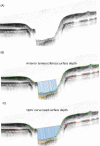Detecting optic nerve head deformation and retinal nerve fiber layer thinning in glaucoma progression
- PMID: 29018667
- PMCID: PMC5602727
- DOI: 10.1016/j.tjo.2015.04.003
Detecting optic nerve head deformation and retinal nerve fiber layer thinning in glaucoma progression
Abstract
The application of digital imaging technologies including confocal scanning laser ophthalmoscopy (CSLO), optical coherence tomography (OCT), and scanning laser polarimetry (SLP) has significantly improved the detection of optic nerve head (ONH) deformation and progressive retinal nerve fiber layer (RNFL) thinning for assessment of glaucoma progression. Algorithms for change analysis such as topographic change analysis and guided progression analysis perform event analysis of serial ONH surface height topology maps and RNFL thickness/RNFL retardance maps, respectively, providing a topographical display of the location of significant change. With spectral-domain OCT, it is feasible to delineate and measure the lamina cribrosa surface depth in addition to ONH surface depth and RNFL thickness. Growing evidence from experimental and clinical studies indicates that ONH and lamina cribrosa deformation can be observed prior to detectable RNFL thinning and functional loss in glaucoma. These findings lend support to the notion that upon detection of ONH/lamina cribrosa deformation, a time window for therapeutic intervention for better outcomes may exist. The ONH and the lamina cribrosa are therefore important targets for monitoring glaucoma progression. This review summarizes the latest findings comparing the performance of OCT, CSLO, and SLP for detection of progressive ONH and RNFL damages in glaucoma patients and the clinical implication and limitations of studying the morphological alteration of the ONH, lamina cribrosa, and RNFL in the assessment of glaucoma progression.
Keywords: glaucoma; guided progression analysis; optic nerve head deformation; retinal nerve fiber layer thinning; topographic change analysis.
Conflict of interest statement
Conflicts of interest: The author has received speaker honorarium from Carl Zeiss Meditec and Heidelberg Engineering, and research support from Carl Zeiss Meditec and Optovue (Fremont, California, USA).
Figures



Similar articles
-
Optic nerve head deformation in glaucoma: the temporal relationship between optic nerve head surface depression and retinal nerve fiber layer thinning.Ophthalmology. 2014 Dec;121(12):2362-70. doi: 10.1016/j.ophtha.2014.06.035. Epub 2014 Aug 6. Ophthalmology. 2014. PMID: 25108319
-
Corneal hysteresis as a risk factor for optic nerve head surface depression and retinal nerve fiber layer thinning in glaucoma patients.Sci Rep. 2021 Jun 3;11(1):11677. doi: 10.1038/s41598-021-90588-7. Sci Rep. 2021. PMID: 34083548 Free PMC article.
-
Retinal nerve fiber layer progression in glaucoma: a comparison between retinal nerve fiber layer thickness and retardance.Ophthalmology. 2013 Dec;120(12):2493-2500. doi: 10.1016/j.ophtha.2013.07.027. Epub 2013 Sep 17. Ophthalmology. 2013. PMID: 24053994
-
Diagnosing glaucoma progression with optical coherence tomography.Curr Opin Ophthalmol. 2014 Mar;25(2):104-11. doi: 10.1097/ICU.0000000000000024. Curr Opin Ophthalmol. 2014. PMID: 24370973 Review.
-
[Aiming for zero blindness].Nippon Ganka Gakkai Zasshi. 2015 Mar;119(3):168-93; discussion 194. Nippon Ganka Gakkai Zasshi. 2015. PMID: 25854109 Review. Japanese.
Cited by
-
Morphological Changes of Glial Lamina Cribrosa of Rats Suffering from Chronic High Intraocular Pressure.Bioengineering (Basel). 2022 Nov 30;9(12):741. doi: 10.3390/bioengineering9120741. Bioengineering (Basel). 2022. PMID: 36550947 Free PMC article.
-
Automated Detection of Retinal Nerve Fiber Layer by Texture-Based Analysis for Glaucoma Evaluation.Healthc Inform Res. 2018 Oct;24(4):335-345. doi: 10.4258/hir.2018.24.4.335. Epub 2018 Oct 31. Healthc Inform Res. 2018. PMID: 30443422 Free PMC article.
-
The Role of Axonal Transport in Glaucoma.Int J Mol Sci. 2022 Apr 1;23(7):3935. doi: 10.3390/ijms23073935. Int J Mol Sci. 2022. PMID: 35409291 Free PMC article. Review.
References
Publication types
LinkOut - more resources
Full Text Sources
Other Literature Sources

